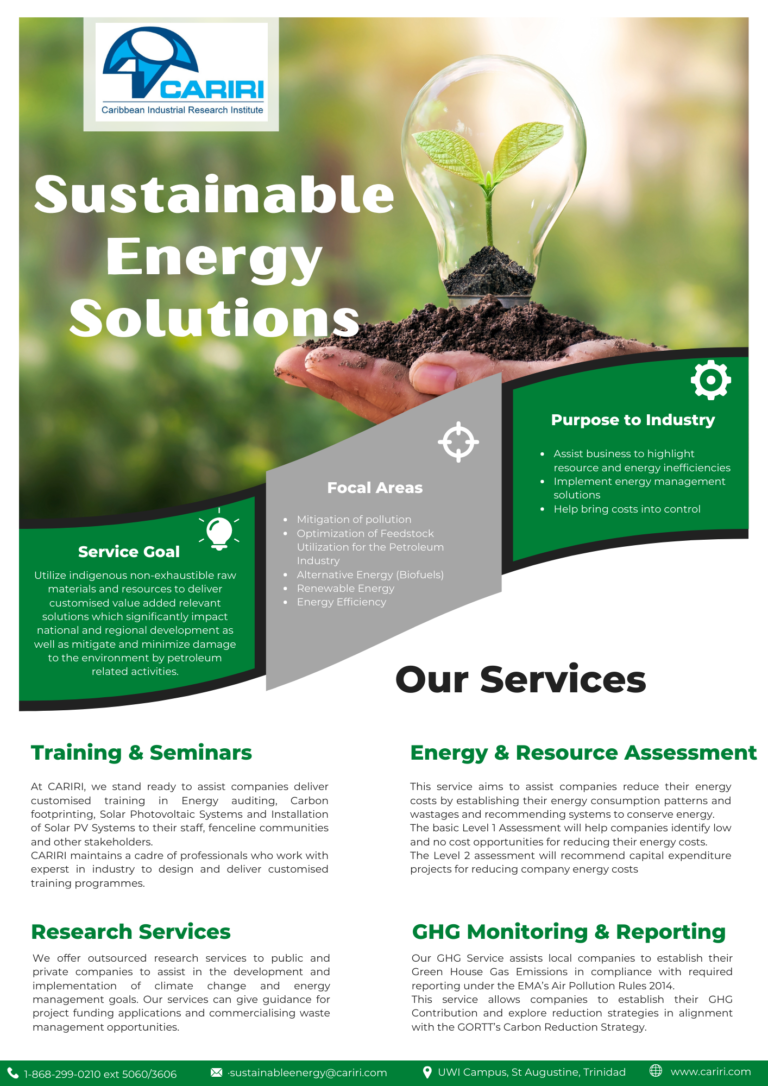What exactly do we mean by Sustainable Energy?
Sustainable Energy is energy that meets the needs of the present generation without compromising the ability of future generations to meet their own needs. We believe that we need to act now to preserve our future resources.
Sustainable Energy uses clean and renewable sources of energy and embraces energy efficiency. We are here to assist you in finding sources that make sense for you and your organization and optimise your energy usage.
Our Vision
We aim to utilize indigenous non-exhaustible raw materials and resources to deliver customized value added relevant sustainability solutions which significantly impact national and regional economic development as well as mitigate and minimize damage to the environment by petroleum related activities.
Our Services
Our professionals stand ready to assist local and regional companies to achieve sustainability in their operations. Whether it is through streamlining their energy and resource usage, adopting renewable energy technology, establishing their Greenhouse gas emissions and carbon footprint or executing Environmental, Social & Governance (ESG) projects we are ready to assist.
Climate change has forced companies to confront the impact of their operations on the environment. As the green energy transition gets underway, local companies must be able to respond to remain competitive.
CARIRI is here to help you take that first step in transitioning to a more sustainable future. We can show you how your organization will save resources by implementing a few small changes that will lead to big payoff in the near future.
Key Services
- Facility energy and resource usage assessments.
- Energy audits/ assessments and assessments of other resource usage, such as water and waste, at client facilities.
- Green house gas monitoring and reporting.
- Assessment of operations and determination of a company’s green house gas emissions.
- Carbon Footprinting.
- Determination of a company’s carbon footprint or the carbon footprint of a specific product or procedure to facilitate trade or marketing.
- Innovative green product development.
- Idea Generation and Implementation (If you have an idea for a green product or process, we make it become a reality).
- Sustainability research.
- Technical research – renewable energy technologies and green energy related topics that will help you with you green projects.
- Customised Renewable Energy/Energy Efficiency Training.
- Basic training programmes in renewable energy and energy efficiency which can be customized to a client’s needs. Using our network of technology experts, we will also design and deliver novel training programmes.
- Information seminars.
- Public seminars on topics relevant to industry in the area of Sustainable Energy.
Focus Areas
- Energy Efficiency
- Renewable Energy
- Alternative Energy
- Optimization of Feedstock Utilization for the Petroleum Industry
- Mitigation of pollution from the petroleum sector
Contact Us
For more information please contact us:
- Eka Rudder-Fairman
- UWI Campus, St Augustine
- 299-0210 Ext 5060
- sustainableenergy@cariri.com
- Mitra Ramlakhan
- UWI Campus, St Augustine
- 299-0210 Ext 3606
- mramlakhan@cariri.com

